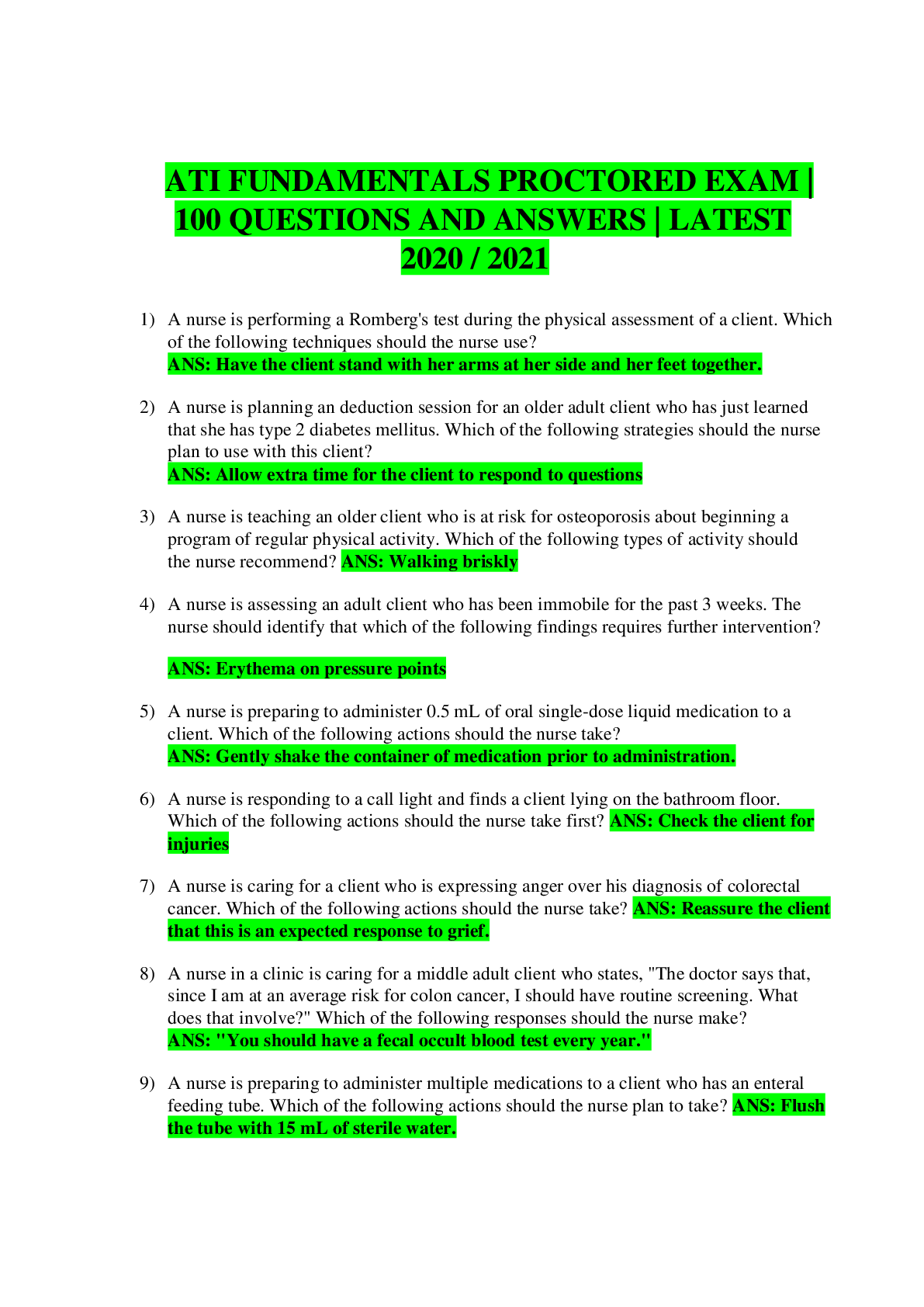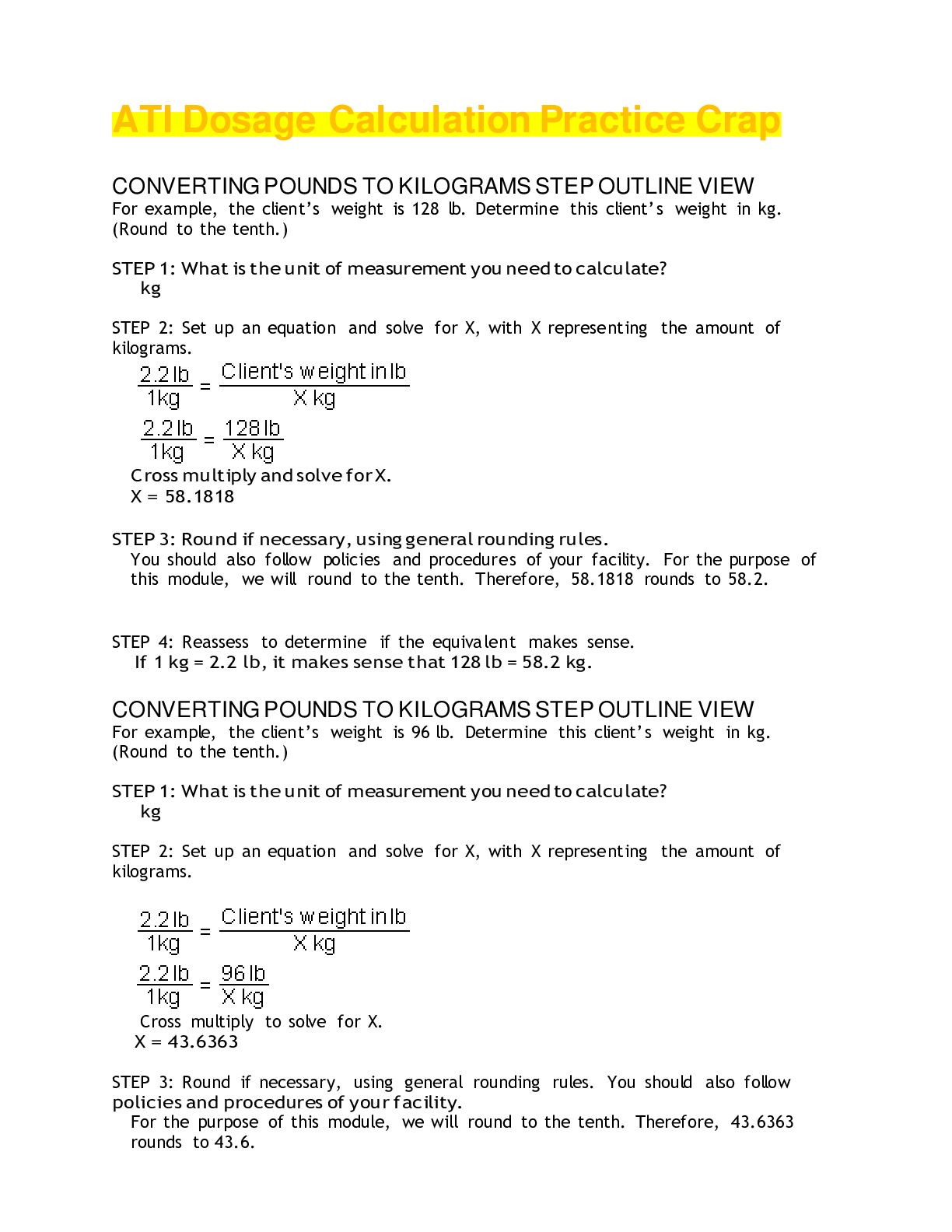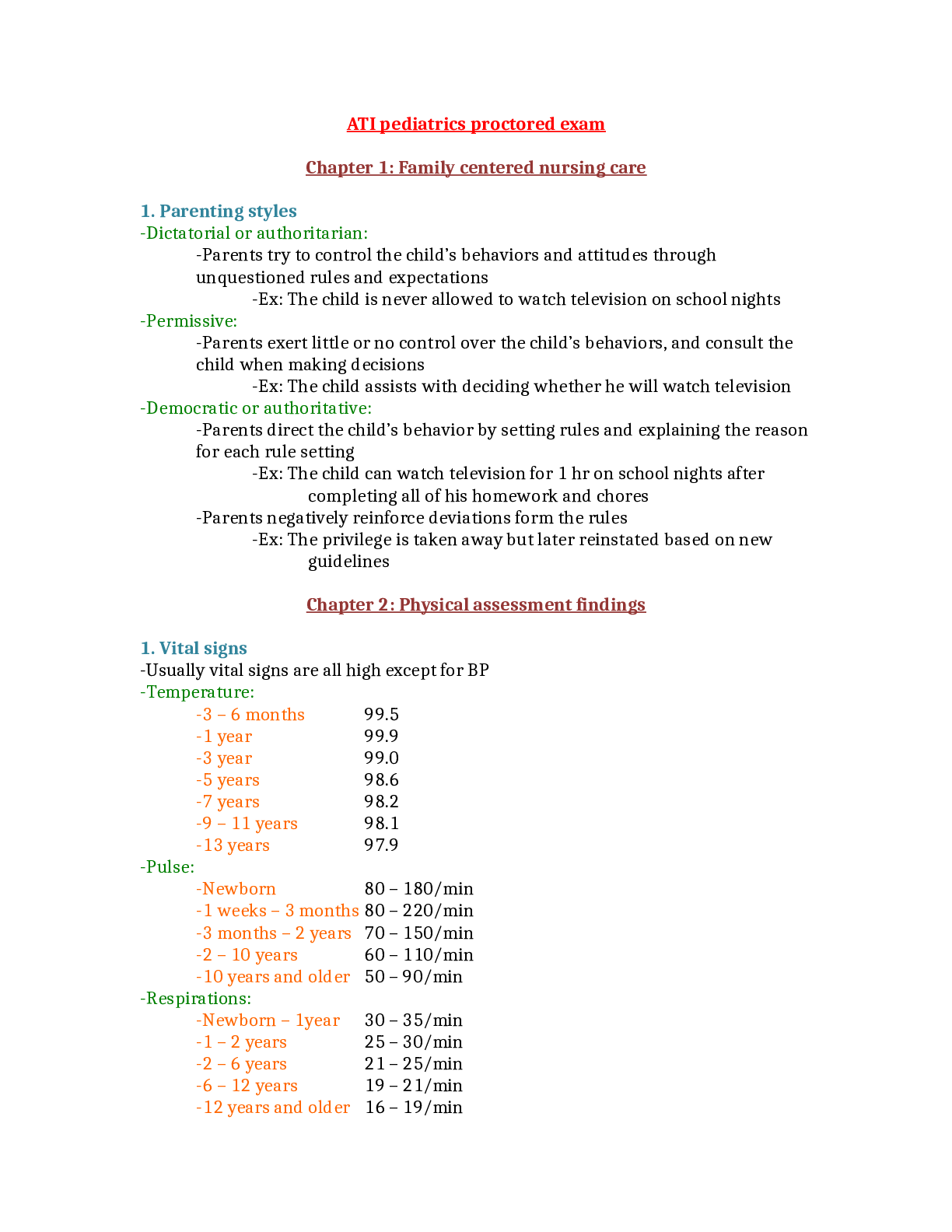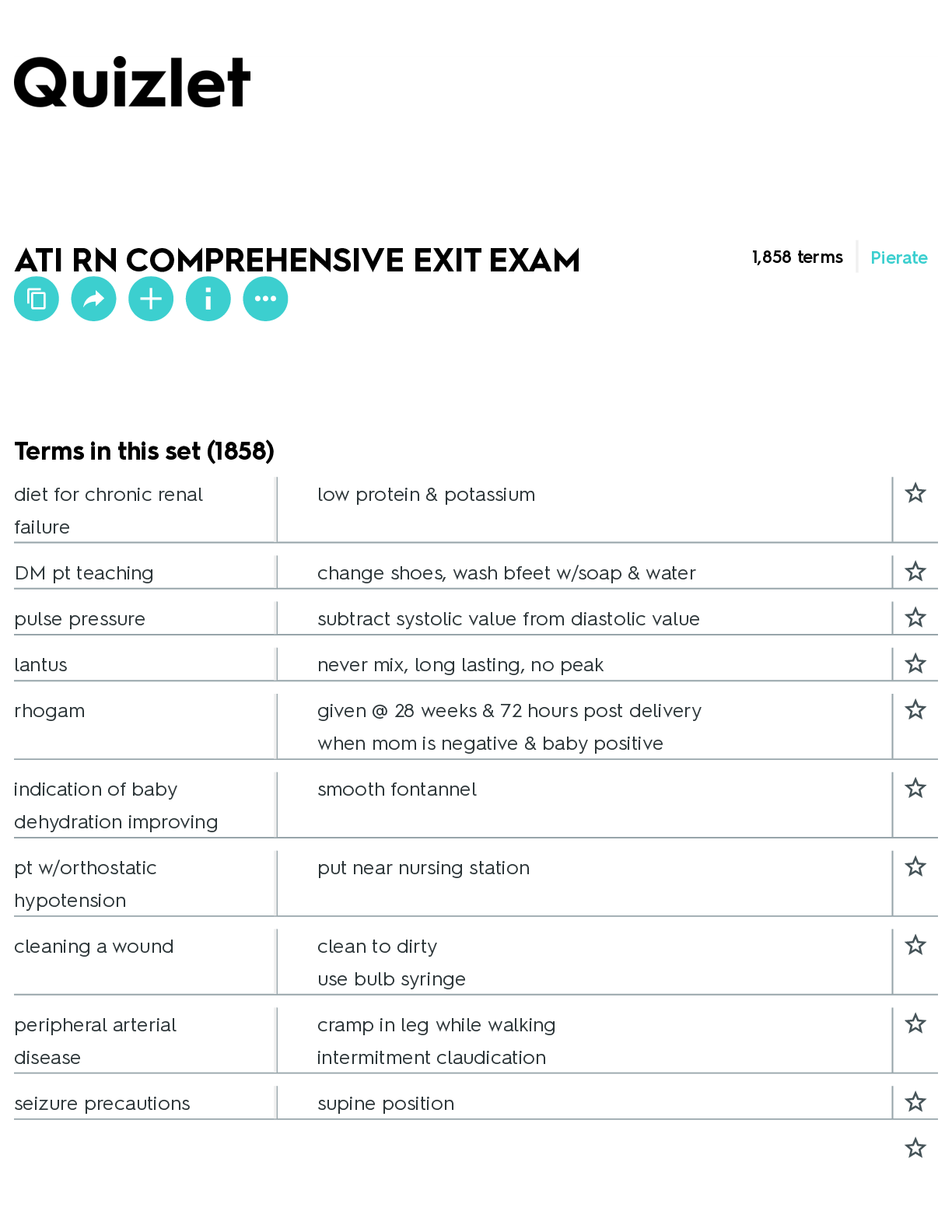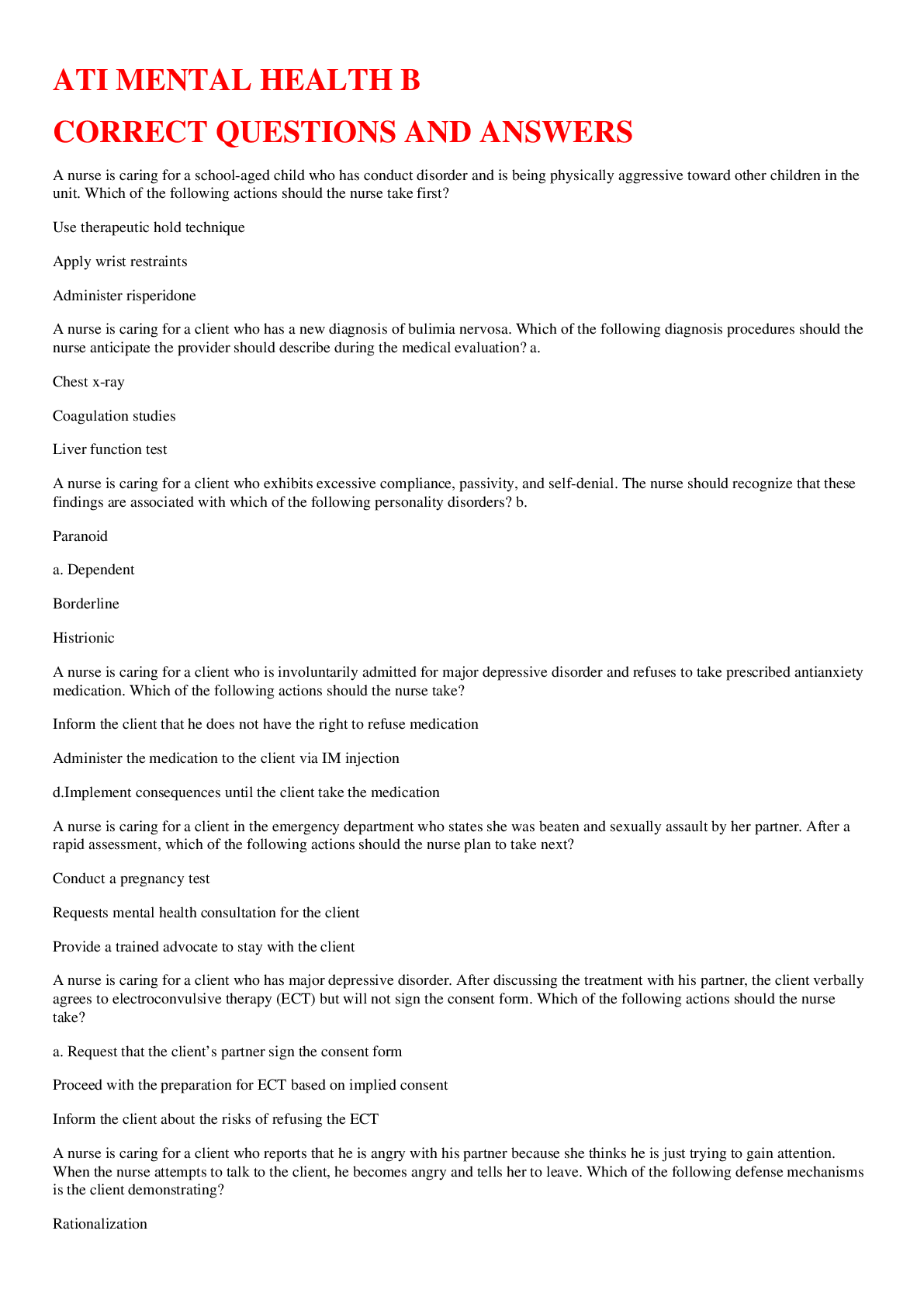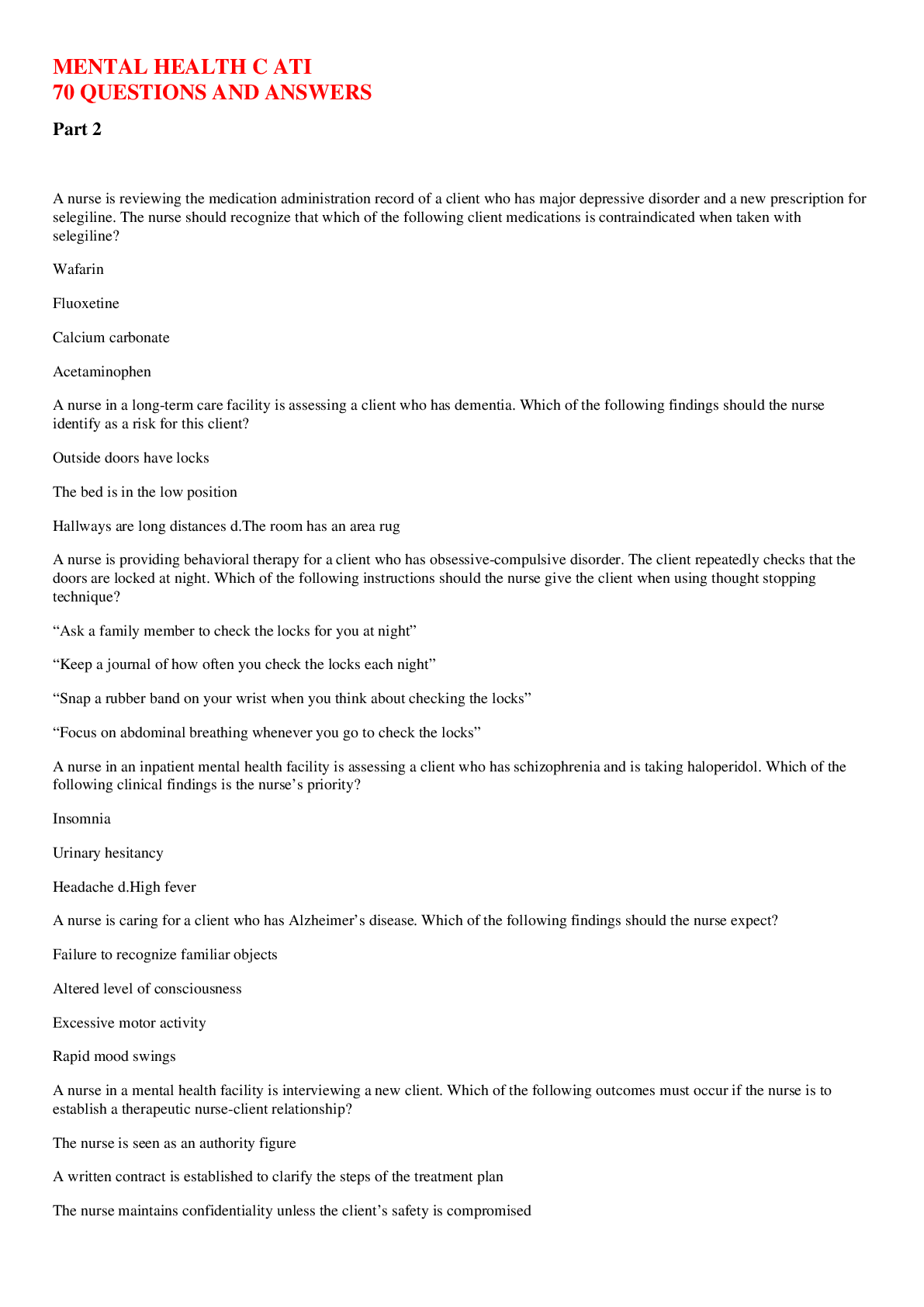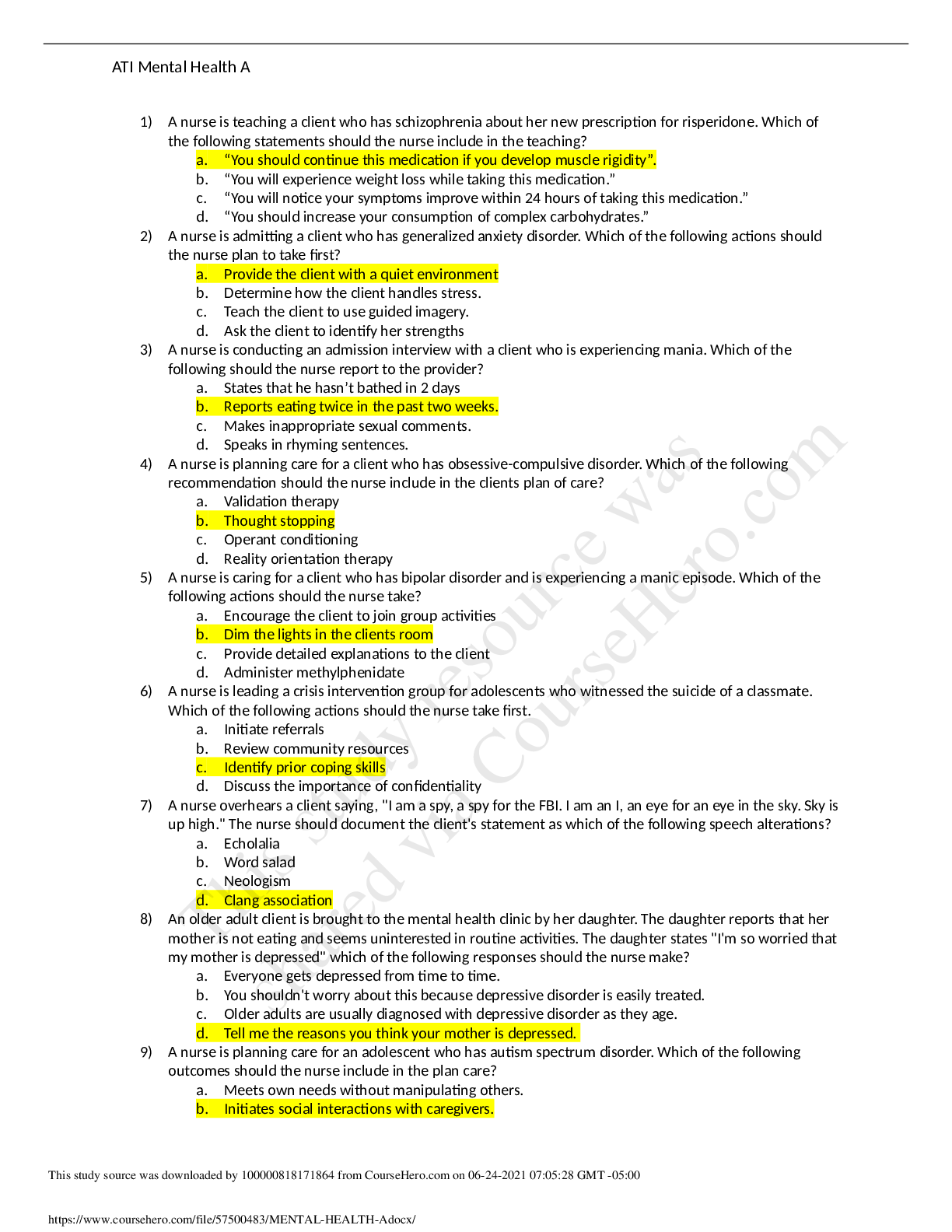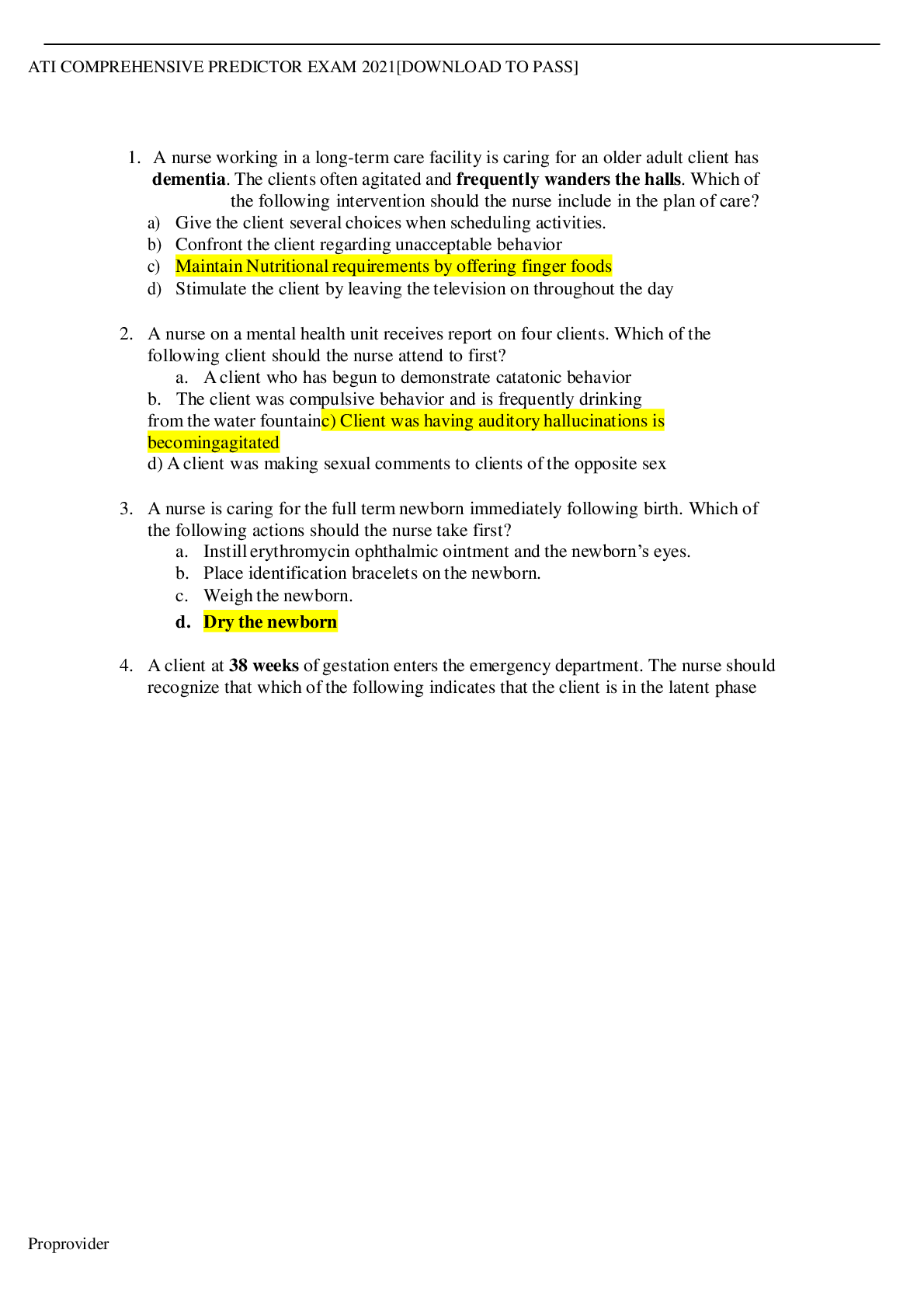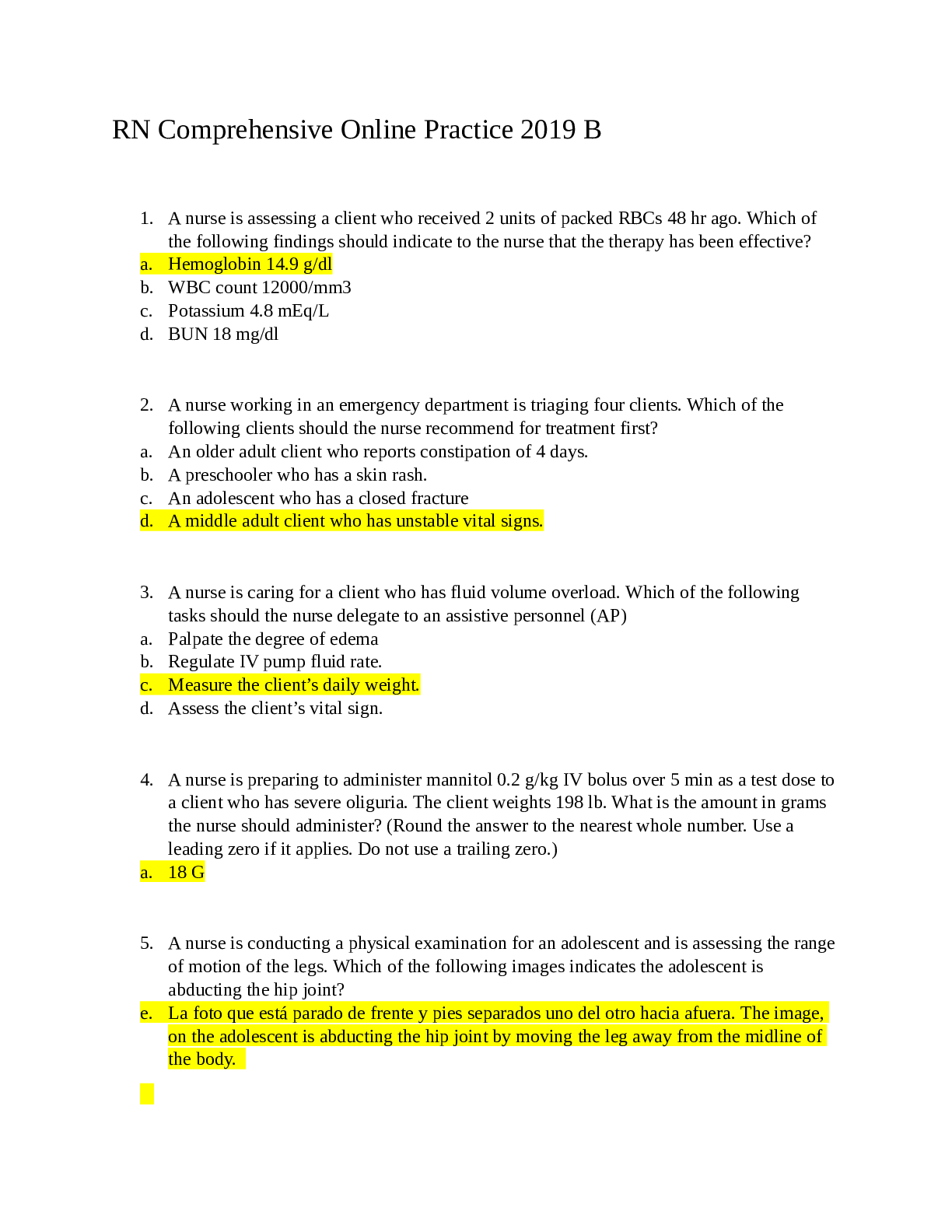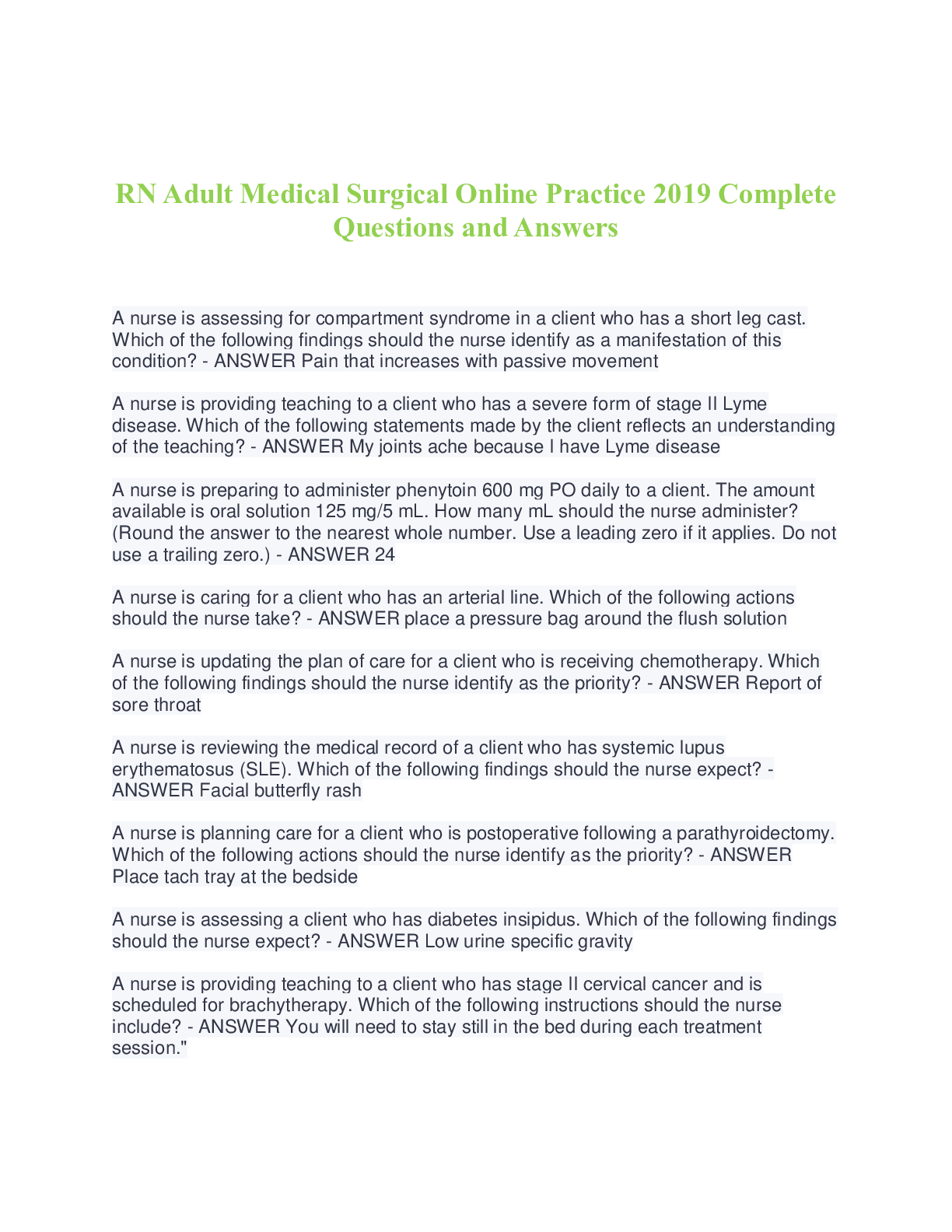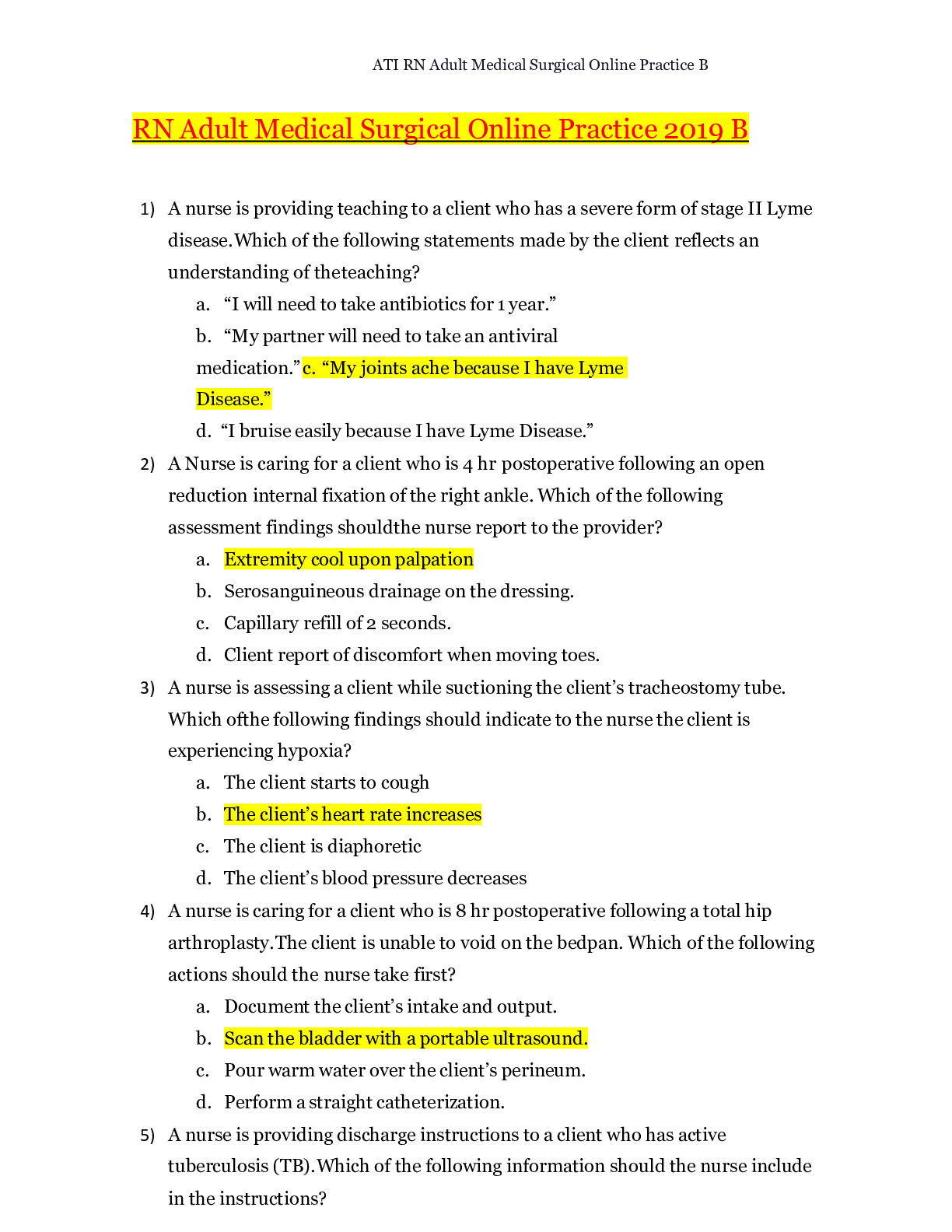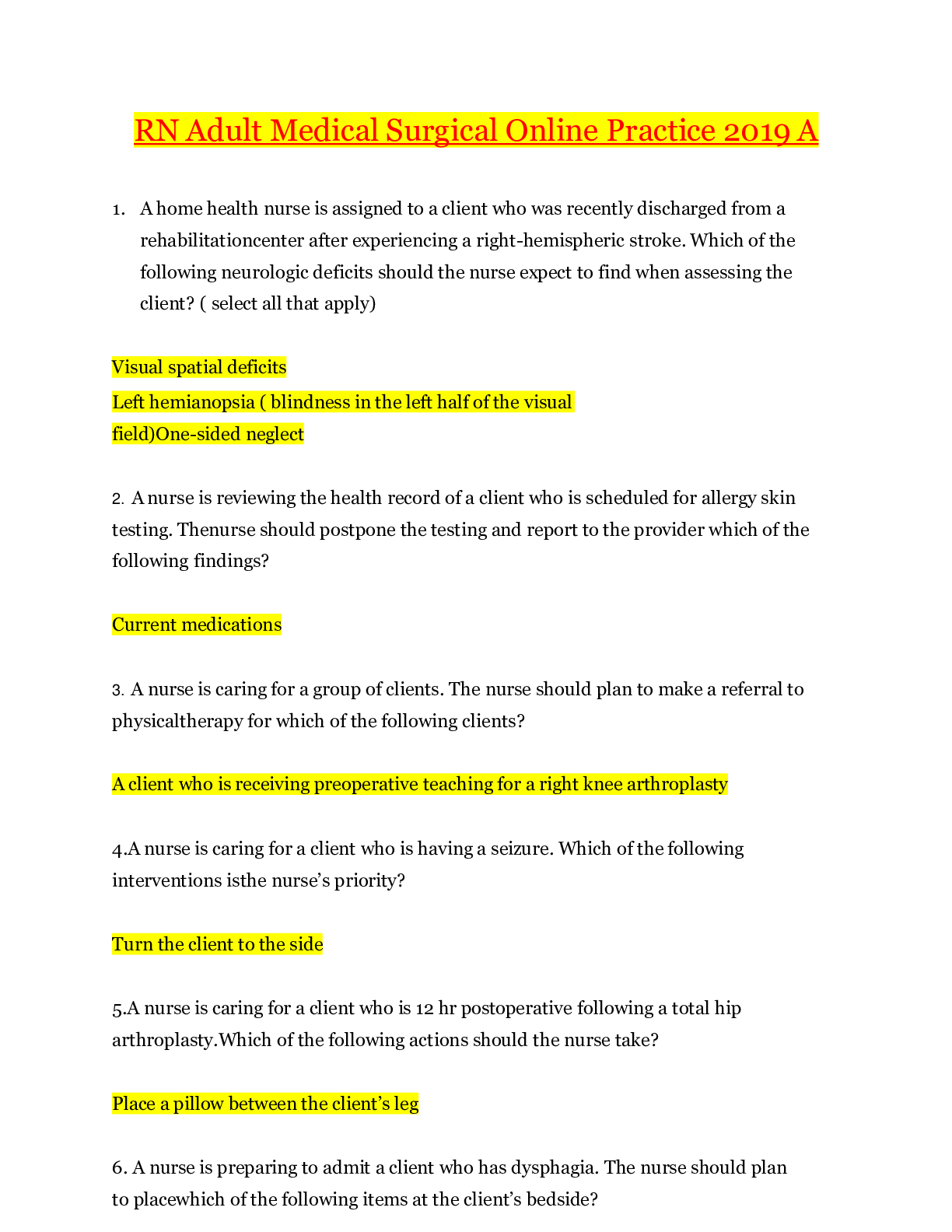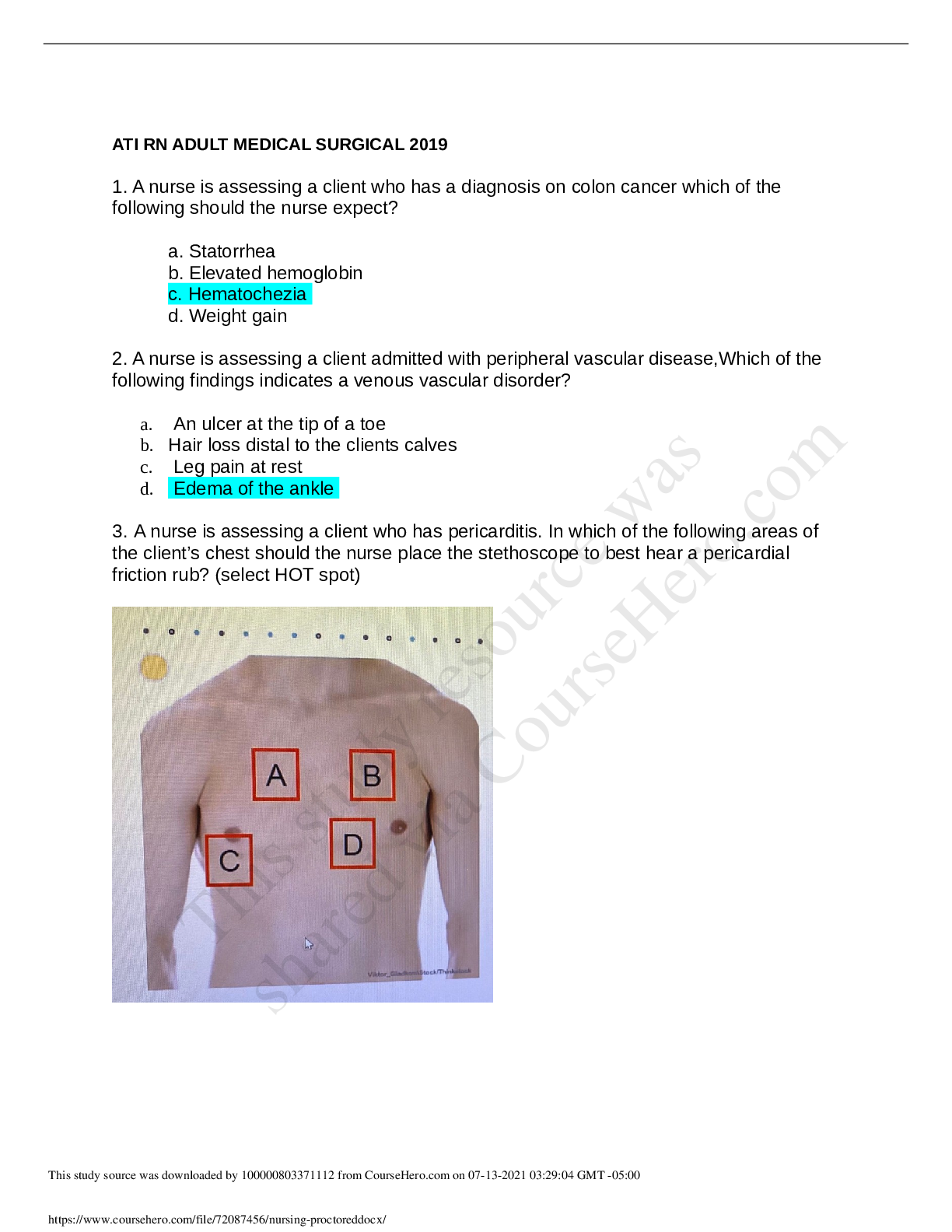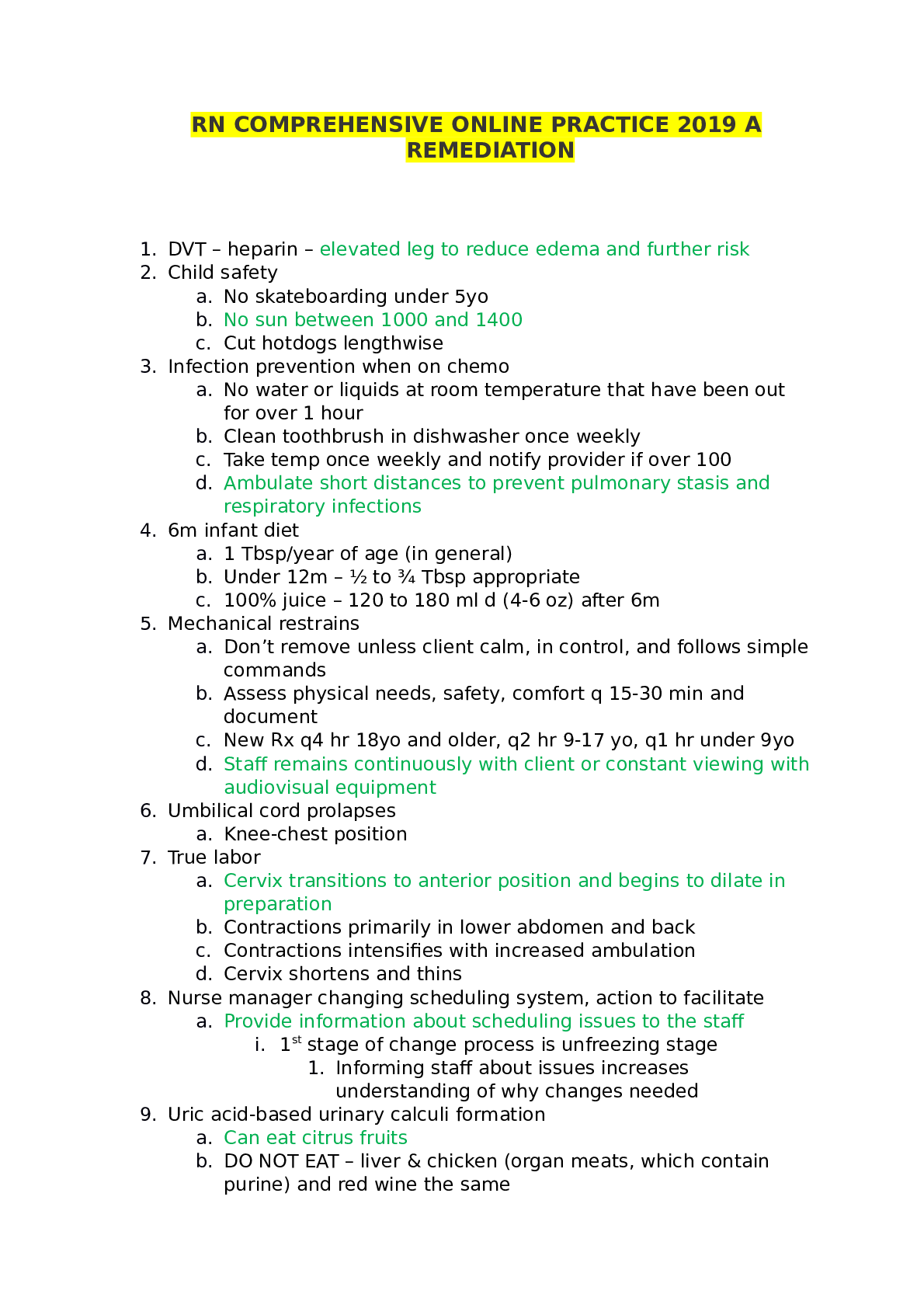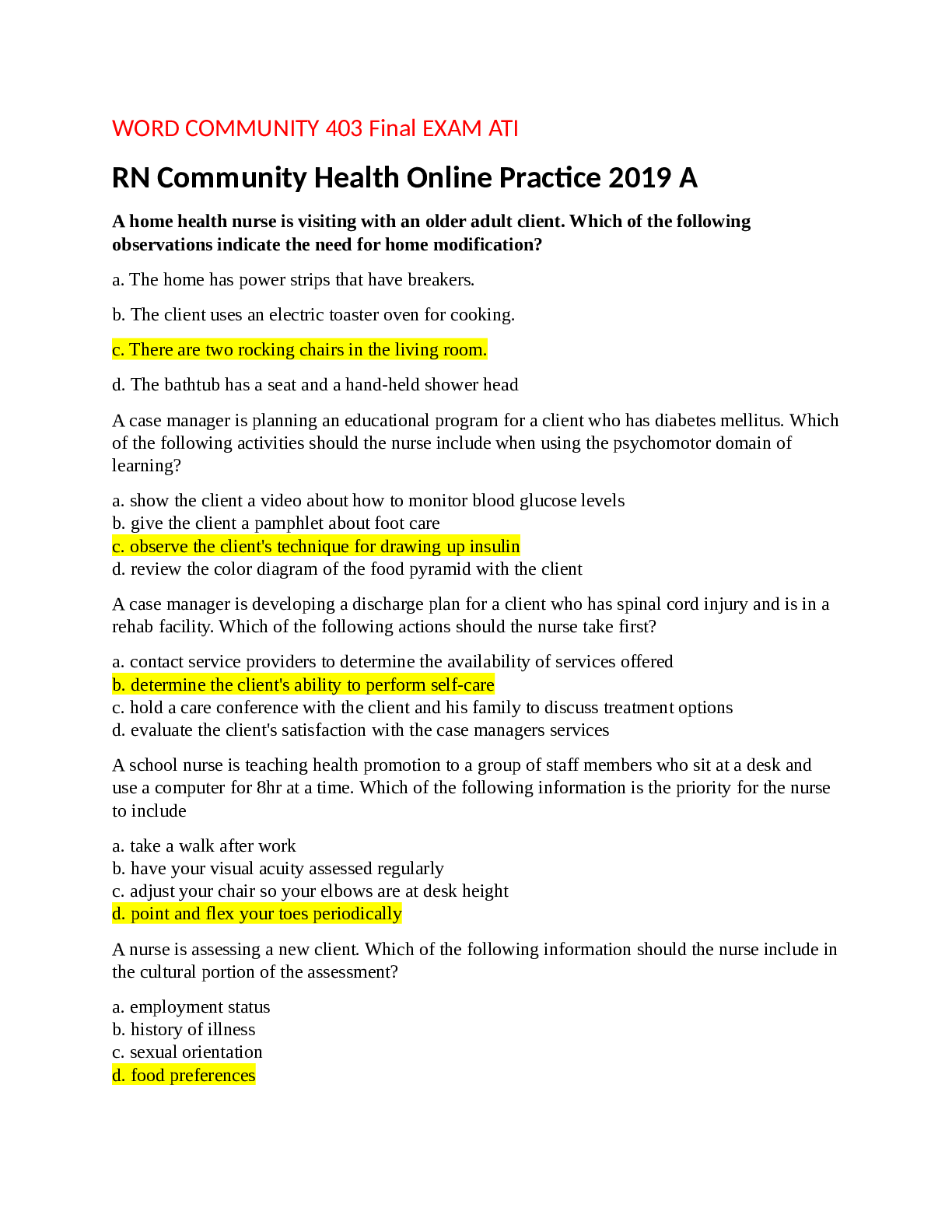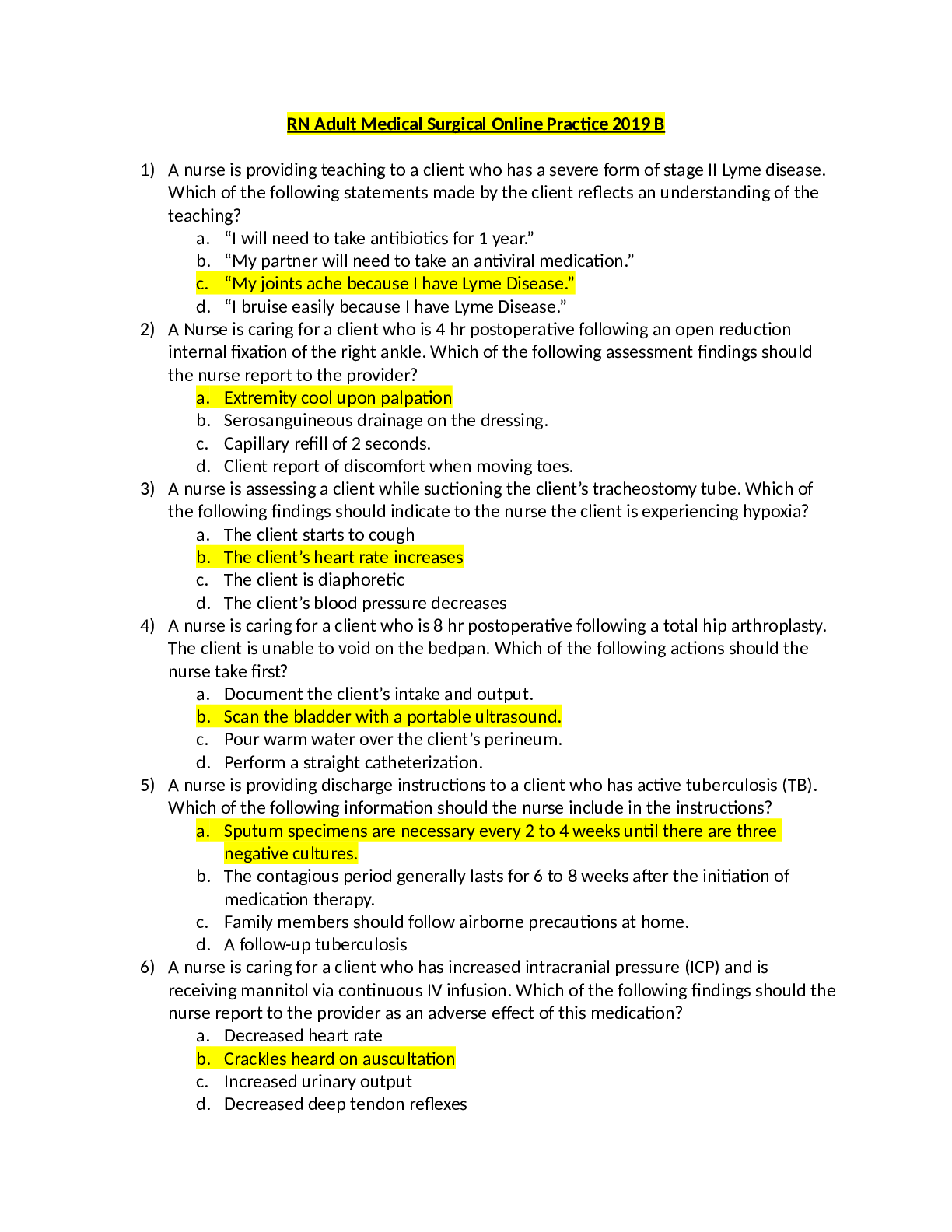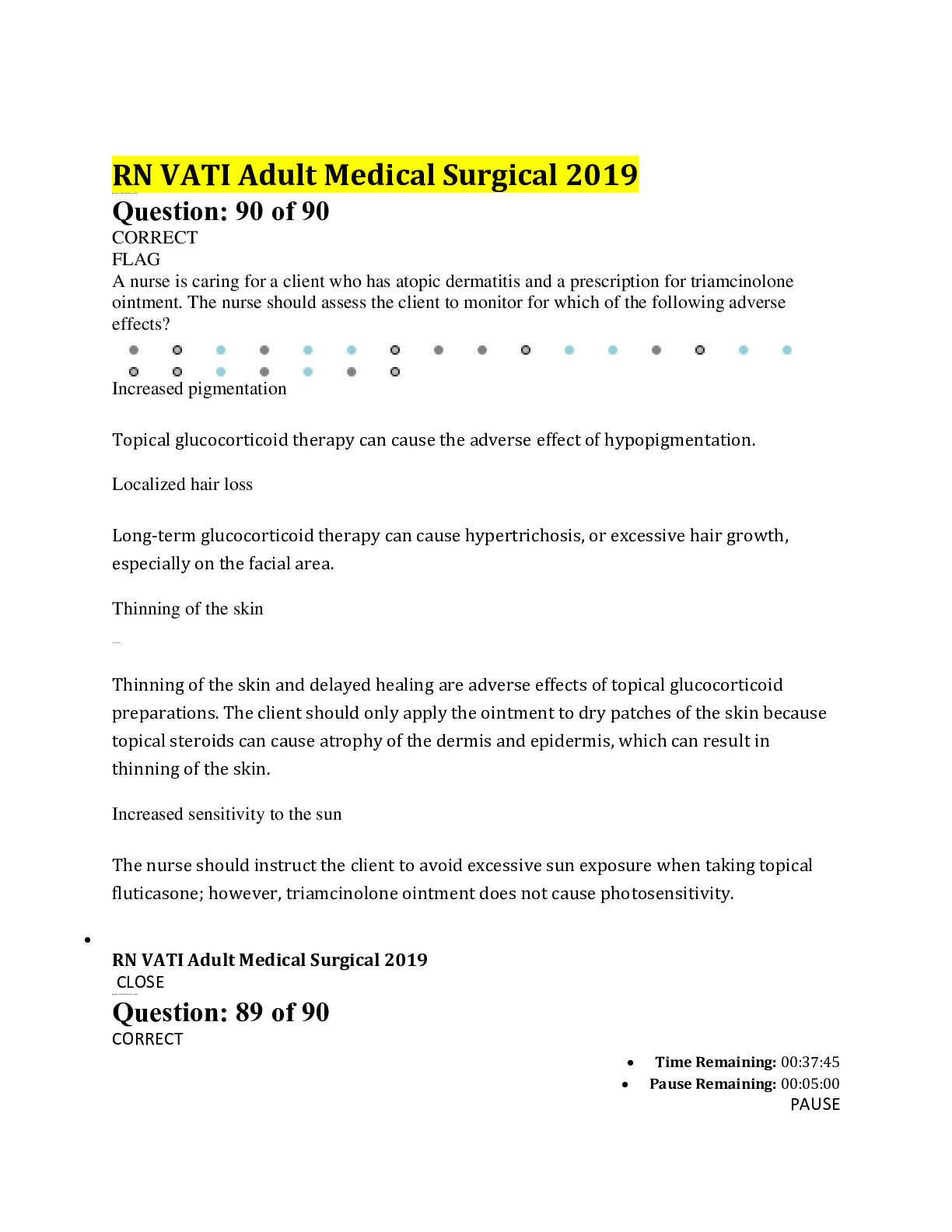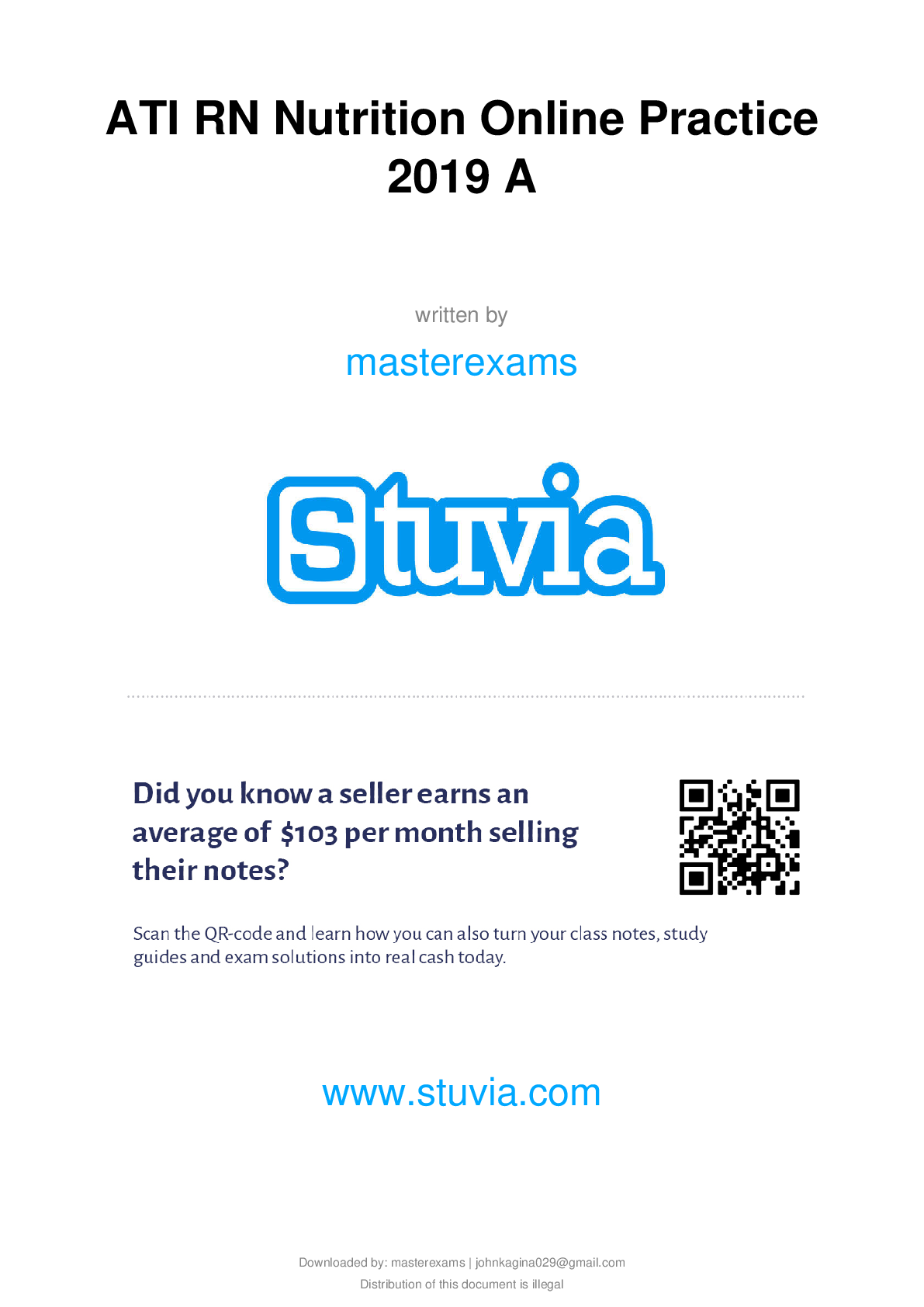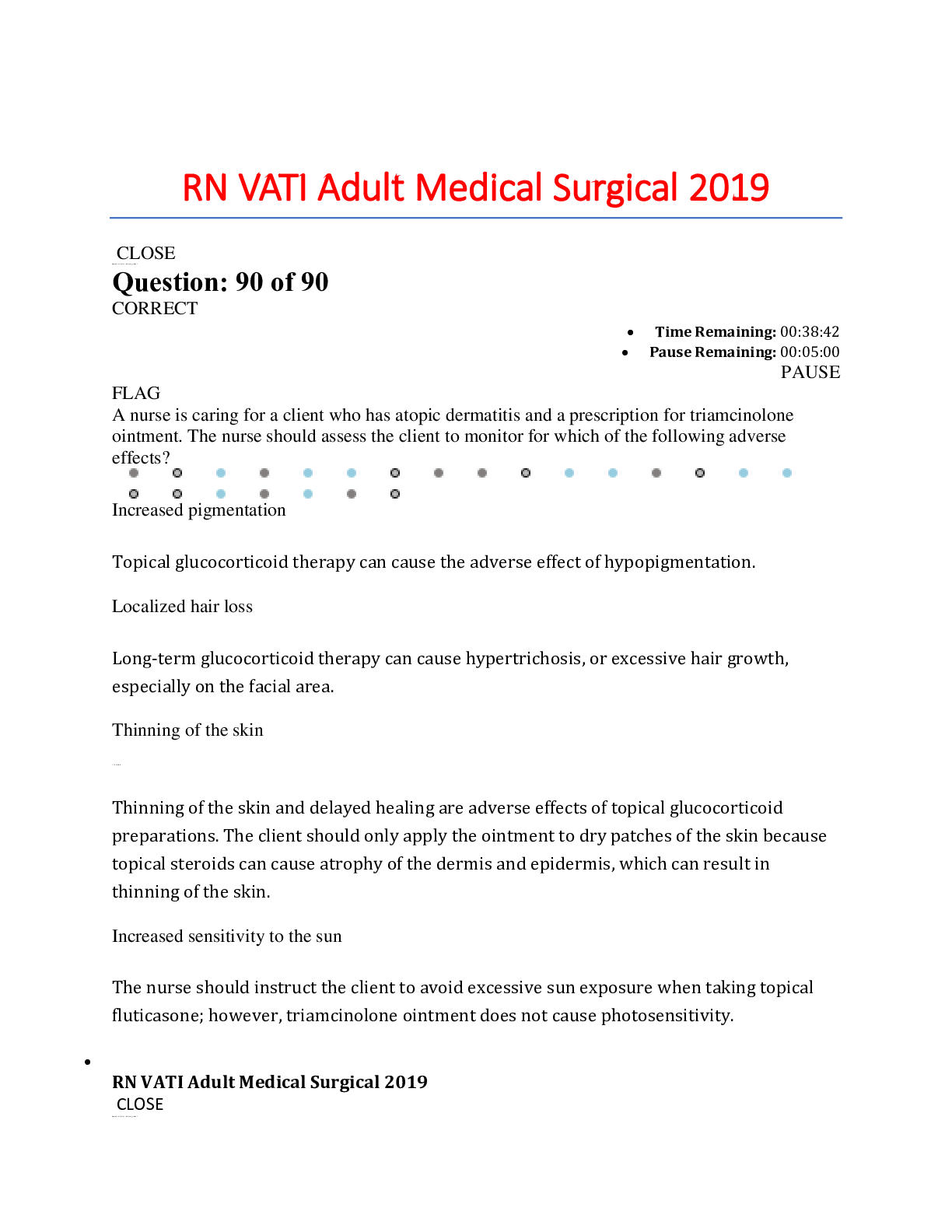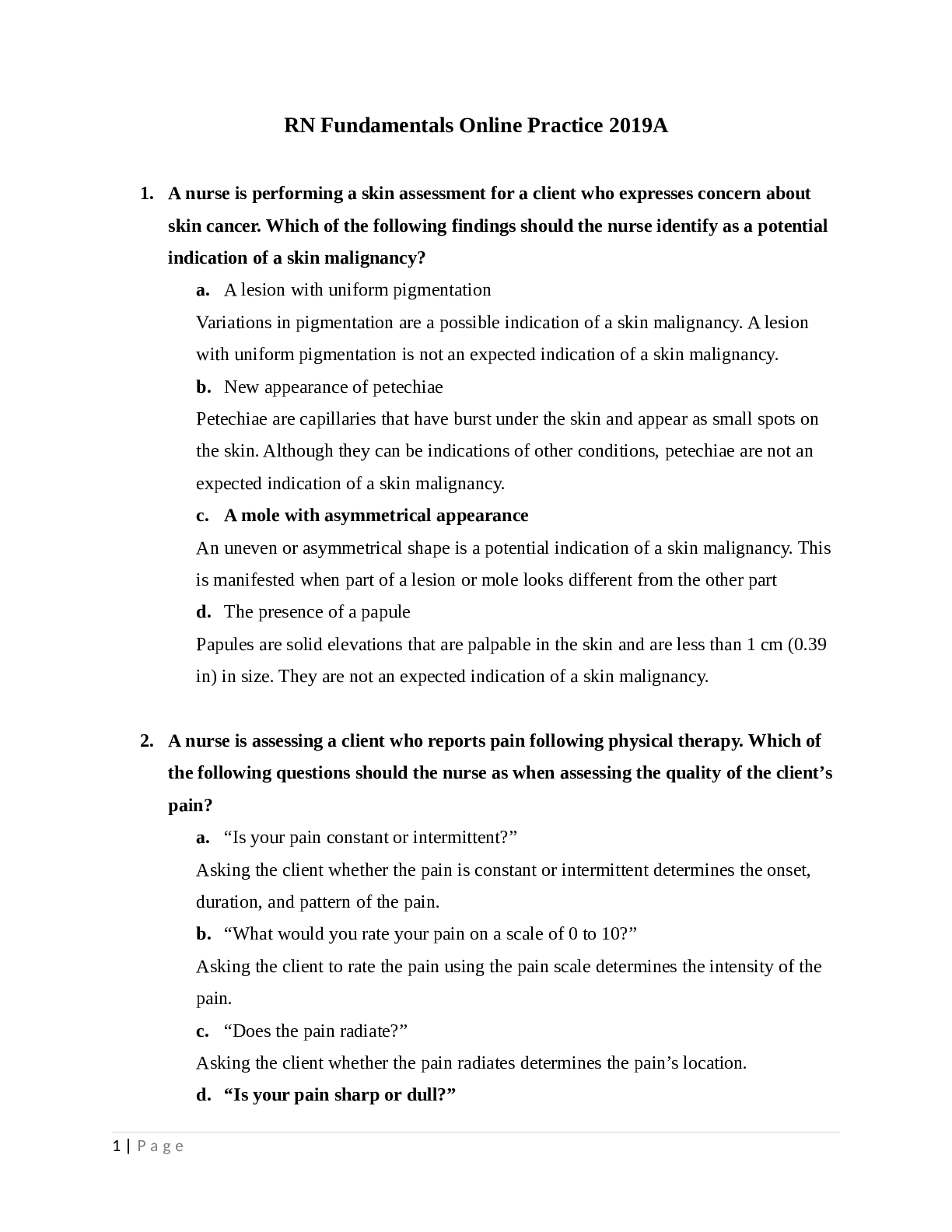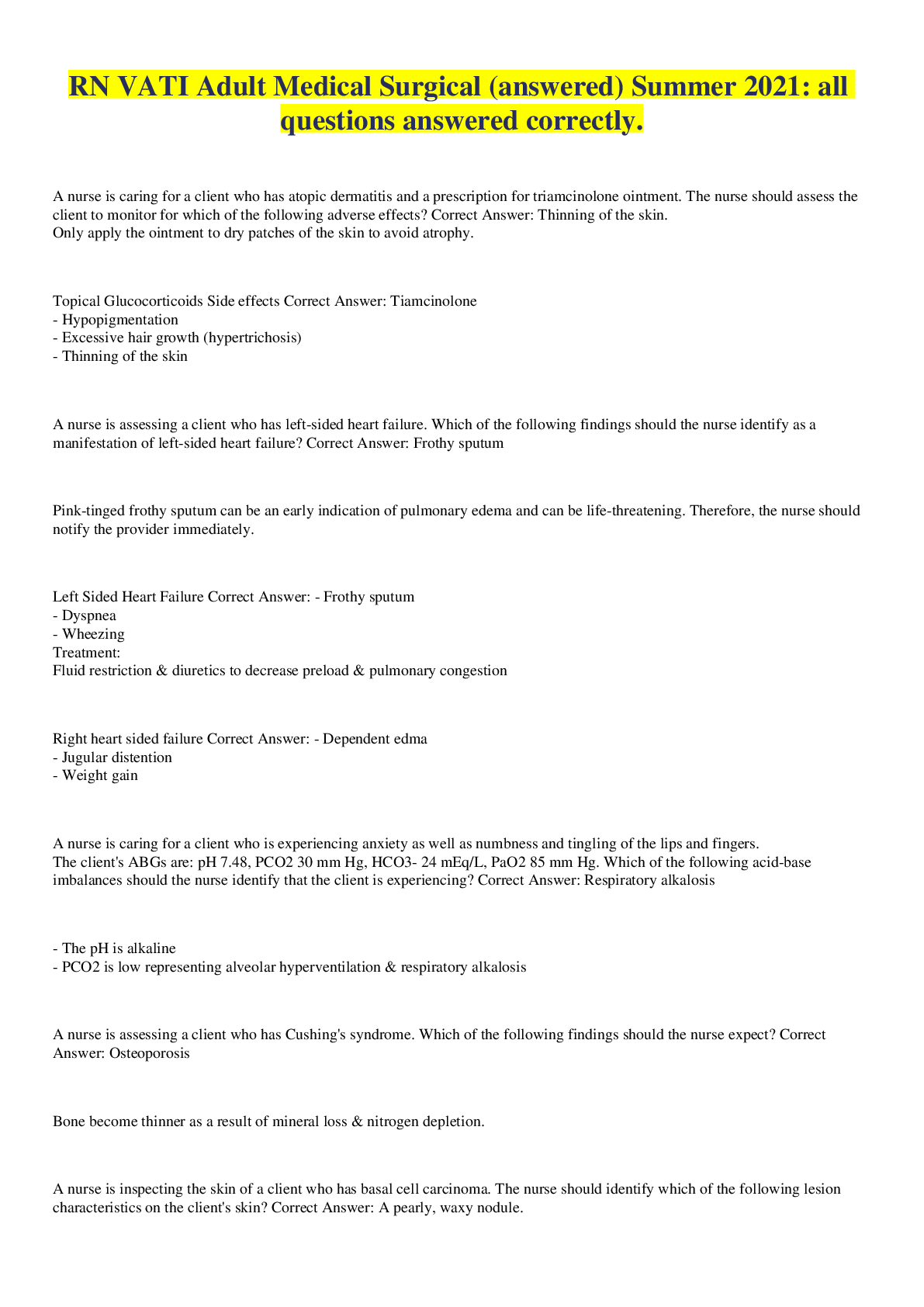*NURSING > QUESTIONS and ANSWERS > ATI: RN Adult Medical Surgical Online Practice 2019 A (All)
ATI: RN Adult Medical Surgical Online Practice 2019 A
Document Content and Description Below
ATI: RN Adult Medical Surgical Online Practice 2019 A 1) A nurse is caring for a client who has hepatic encephalopathy that is being treated with lactulose. The client is experiencing excessive sto... ols. Which of the following findings is an adverse effect of this medication? a. Hypokalemia b. Hypercalcemia c. Gastrointestinal bleeding d. Confusion 2) A nurse is caring for a client who has emphysema and is receiving mechanical ventilation. The client appears anxious and restless, and the high-pressure alarm is sounding. Which of the following actions should the nurse take first? a. Obtain ABGs b. Administer propofol to the client c. Instruct the client to allow the machine to breathe for them. d. Disconnect the machine and manually ventilate the client 3) A nurse is teaching a client who has family history of colorectal cancer. To help mitigate this risk, which of the following dietary alterations should the nurse recommend? a. Add full-fat yogurt to the diet b. Add cabbage to the diet c. Replace butter with coconut oil d. Replace shellfish with red meat 4) A home health nurse is assigned to a client who was recently discharged from a rehabilitation center after experiencing a right-hemispheric stroke. Which of the following neurological deficits should the nurse expect to find when assessing the client? (Select all that apply) a. Expressive aphasia b. Visual spatial deficits c. Left hemianopsia d. Right hemiplegia e. One-sided neglect 5) A nurse is caring for a client who has viral pneumonia. The client’s pulse oximeter readings have fluctuated between 79% and 88% for the last 30 min. Which of the following oxygen delivery systems should the nurse initiate to provide the highest concentration of oxygen? a. Nonrebreather mask b. Venturi mask c. Simple face mask d. Partial rebreather mask 6) A nurse is caring for a client who has bilateral pneumonia and an SaO2 of 85%. The client has dyspnea with a productive cough and it using accessory muscles to breathe. Which of the following actions should the nurse take first? a. Obtain a prescription for ABGS b. Administer IV antibiotics to the clientc. Instruct the client to use the incentive spirometer d. Place the client in high-Fowler’s position 7) A nurse is planning care for a client who has extensive burn injuries and is immunocompromised. Which of the following precautions should the nurse include in the plan of care to prevent a Pseudomonas aeruginosa infection? a. Encourage the client eat raw fruits and vegetables. b. Avoid placing plants or flowers in the client’s room c. Limit visitors to members of the client’s immediate family d. Wear an N95 respirator mask when providing care to the client. 8) An older adult client is brought to an emergency department by a family member. Which of the following assessment findings should cause the nurse to suspect that the client has hypertonic dehydration? a. Serum sodium level 145 mEq/L b. Forearm skin tents when pinched c. Respiratory rate decreased d. Urine specific gravity 1.045 9) A nurse is an emergency department is reviewing the provider’s prescriptions for a client who sustained a rattlesnake bite to the lower leg. Which of the following prescriptions should the nurse expect? a. Apply ice to the client’s puncture wounds. b. Initiate corticosteroid therapy for the client c. Keep the client’s leg above heart level d. Administer an opioid analgesic to the client 10) A nurse is assessing a client who has had a suspected stroke. The nurse should place the priority on which of the following findings? a. Dysphagia b. Aphasia c. Ataxia d. Hemianopsia 11) A nurse is teaching a young adult client how to perform testicular self-examination. Which of the following instructions should the nurse include? a. Compare both testicles by examining them simultaneously b. Roll each testicle between the thumb and fingers c. Perform testicular self-examination before a warm bath or shower d. Perform self-examination of the testicles every 2 weeks 12) A nurse is providing instructions to a client who has type 2 diabetes mellitus and a new prescription for metformin. Which of the following statements by the client indicates an understanding of the teaching? a. “I will monitor my blood sugar carefully because the medication increases the secretion of insulin.” b. “I should take this medication with a meal.” c. “I can expect to gain weight while taking this medication.” d. “While taking this medication, I will experience flushing of my skin.”13) A Nurse is teaching a client who has venous insufficiency about self-care. Which of the following statements should the nurse identify as an indication that the client understanding the teaching? a. “I should avoid walking as much as possible.” b. “I should sit down and read for several hours a day.” c. “I will wear clean graduated compression stockings every day.” d. “I will keep my legs level with my body when I sleep at night.:” 14) A nurse is assessing a client who has acute cholecystitis. Which of the following findings is the nurse’s priority? a. Anorexia b. Abdominal pain radiating to the right shoulder c. Tachycardia d. Rebound abdominal tenderness 15) A nurse is reviewing the health record of a client who is scheduled for allergy skin testing. The nurse should postpone the testing and report to the provider which of the following findings? a. Disease processes b. Laboratory findings i. Blood glucose (fasting) 102 mg/dL ii. BUN 15 mg/dL iii. Creatinine 1 mg/dL iv. Prostate Specific Antigen (PSA) 1.5 mg/mL c. Current medications i. Ibuprofen PRN for headaches ii. Olmesartan 20p mg PO daily iii. Prednisone 5 mg PO daily d. Family history i. Gouty arthritis for 3 years ii. Hypertension diagnosed 5 years ago iii. 1 pack per day cigarette use for 15 years iv. Family history of prostate cancer 16) A nurse is caring for a group of clients. The nurse should plan to make a referral to physical therapy for which of the following clients? a. A client who is receiving preoperative teaching for a right knee arthroplasty b. A client who states they will have difficulty obtaining a walker for home use. c. A client who reports an increase in pain following a left hip arthroplasty d. A client who is having emotional difficulty accepting that they have a prosthetic leg 17) A nurse is caring for a client who has diabetic ketoacidosis (DKA). Which of the following laboratory findings should the nurse expect? a. Negative urine ketones b. BUN 32 mg/dL c. pH 7.43 d. HCO3 -23 mEq/L18) A nurse is planning teaching for a client who has bladder cancer and is to undergo a cutaneous diversion procedure to establish a ureterostomy. Which of the following statements should the nurse include in the teaching? a. “You will still have the urge to void.” b. “You can apply an aspirin tablet to the pouch to reduce odor.” c. “You should cut the opening of the skin barrier one-eighth inch wider than the stoma.” d. “You should use a moisturizing soap when washing the skin around the stoma.” 19) A nurse is providing teaching for a female client who has recurrent urinary tract infections. Which of the following information should the nurse include in the teaching? a. Take tub baths daily b. Drink at least 1 L of fluid daily c. Wear underwear made of nylon d. Void before and after intercourse 20) A nurse and an assistive personnel (AP) are caring for a client who has bacterial meningitis. The nurse should give the AP which of the following instructions? a. Wear a mask b. Wear a gown c. Keep the client’s room well-lit d. Maintain the head of the bed at a 45 degree elevation 21) A nurse is caring for a client who is 12 hr postoperative following a total hip arthroplasty. Which of the following actions should the nurse take? a. Maintain adduction for the client’s legs b. Encourage range of motion of the hip up to 120 angle c. Place a pillow between the client’s legs d. Keep the client’s hip internally rotated 22) A nurse in a provider’s office is assessing a client who has migraine headaches and is taking feverfew to prevent headaches. The nurse should identify that which of the following client medications interacts with feverfew? a. Metoprolol b. Bupropion c. Naproxen d. Atorvastatin 23) A nurse is caring for a client who has pancreatitis. The nurse should expect which of the following laboratory results to be below the expected reference range? a. Amylase b. Alkaline phosphatase c. Bilirubin d. Calcium 24) A nurse is providing discharge instructions to a client following an upper gastrointestinal series with barium contrast. Which of the following information should the nurse provide? a. Increase fluid intake b. Take an over-the-counter antidiarrheal medicationc. Expect black, tarry stools d. Follow a low-fiber diet 25) A nurse is assessing a client who had extracorporeal shock wave lithotripsy (ESWL) 6 hr ago. Which of the following findings should the nurse expect? a. Stone fragments in the urine b. Fever c. Decreased urine output d. Bruising on the lower abdomen 26) A nurse is assessing a group of clients for indications of role changes. The nurse should identify that which of the following clients is at risk for experiencing a role change? a. A client who has type 1 diabetes mellitus and is starting to self-monitor blood glucose. b. A client who had a cholecystectomy and is starting on a modified-fat diet c. A client who has Crohn’s disease and is experiencing diarrhea three times a dy. d. A client who has multiple sclerosis and is experiencing progressive difficulty ambulating. 27) A nurse is caring for a client who has a new diagnosis of hyperthyroidism. Which of the following is the priority assessment finding that the nurse should report the provider? a. Restlessness b. T3 level 215 ng/dL c. Blood pressure 170/80 mm Hg d. Decreased weight 28) A nurse is providing discharge instructions to a client who has a partial thickness burn on the hand. Which of the following instructions should the nurse include? a. Change the dressing every 72 hr b. Immobilize the hand with a pressure dressing c. Take pain medication 30 min after changing the dressing d. Wrap fingers with individual dressings 29) A nurse is providing teaching to a client who is receiving chemotherapy and has new prescription of epoetin alfa. Which of the following client statements indicates an understanding of the teaching? a. “I will monitor my blood pressure while taking this medication.” b. “I should take a vitamin D supplement to increase the effectiveness of the medication.” c. “I should inform the provider if I experience an increased appetite while taking this medication.” d. “I will decrease the amount of protein in my diet while taking this medication.” 30) A nurse is providing discharge teaching to a client who has heart failure and a new prescription for a potassium-sparing diuretic. Which of the following information should the nurse include in the teaching? a. Try to walk at least three times per week for exercise. b. To increase stamina, walk for 5 min after fatigue beings. c. Take over-the-counter cough medicine for persistent cough d. Use a salt substitute to reduce sodium intake.31) A nurse is caring for client who has HIV. Which of the following findings indicates a positive response to the prescribed HIV treatment? a. Decreased T cells b. Increased creatinine clearance c. Increased eosinophils d. Decreased viral load 32) A nurse is caring for a client who is postoperative following a total hip arthroplasty. Which of the following laboratory values should the nurse report to the provider? a. Potassium 4 mEq/L b. WBC count 10,000/mm3 c. Hct 45% d. Hgb 8 g/dL 33) A nurse is assessing a client who has had a plaster cast applied to their left leg 2 hr ago. Which of the following actions should the nurse take? a. Inspect the cast for drainage once every 24 hours. b. Check that one finger fits between the cast and the leg c. Perform neurovascular checks every 2 to 3 hours d. Make sure the client has a warm blanket covering the cast. 34) A nurse is providing teaching to a client who has chronic kidney disease and a new prescription for erythropoietin. Which of the following statements by the client indicates an understanding of the teaching? a. “I should take calcium supplements so the medication will work better in my system.” b. “I am taking this medication to increase my energy level.” c. “This medication can cause my blood pressure to drop.” d. “I will not need to restrict protein in my diet while taking this medication.” 35) A nurse is caring for a client who is undergoing hemodialysis to treat end-stage kidney disease (ESKD). The client reports muscle cramps and a tingling sensation in their hands. Which of the following medications should the nurse plan to administer? a. Epoetin alfa b. Furosemide c. Captopril d. Calcium carbonate 36) A nurse in a community clinic is caring for a client who reports an increase in the frequency of migraine headaches. To help reduce the risk for migraine headaches, which of the following foods should the nurse recommend the client avoid? a. Shellfish b. Aged cheese c. Peppermint candy d. Enriched pasta 37) A nurse is providing teaching to a female client who has a history of urinary tract infections (UTIs). Which of the following information should the nurse include in the teaching? a. Avoid foods that are high in ascorbic acid.b. Add oatmeal to the water when taking a tub bath c. Urinate every 6 hr d. Take daily cranberry supplements 38) A nurse is performing a dressing change for a client who is recovering from a hemicolectomy. When removing the dressing, the nurse notes that a large part of the bowel is protruding through the abdomen. Which of the following actions should the nurse take first? a. Place the client in a supine position b. Measure vital signs c. Cover the wound with a sterile, saline-moistened dressing d. Call for help 39) A nurse is preparing to administer a unit of packed RBCs to a client. Which of the following actions should the nurse take? a. Remain with the client for the first 15 min of the infusion b. Prime the blood administration IV tubing with lactated Ringer’s solution. c. Verify the client’s identify by using the client’s room number prior to starting the transfusion. d. Infuse the unit of packed RBCs within 8 hr. 40) A nurse is evaluating a client who has a new diagnosis of type 1 diabetes mellitus. Which of the following client statements indicates the client is successfully coping with the change? a. “It is just easier to let my partner administer my insulin.” b. “I used to never worry about my feet. Now, I inspect my feet every day with a mirror.” c. “I’m concerned I won’t be able to read my blood sugar level because the screen is so small.” d. “I know a lot of people who have diabetes and do not take insulin. I wish I didn’t have to.” 41) A nurse is caring for a client who has a closed head injury and has an intraventricular catheter placed. Which of the following findings indicates that the client is experiencing increased intracranial pressure (ICP)? Select all that apply. a. Flat jugular veins b. A Glasgow coma scale score of 15 c. Sleepiness exhibited by the client d. Widening pulse pressure e. Decerebrate posturing 42) A nurse is planning to provide discharge teaching for the family of an older adult client who has hemianopsia and is at risk for falls. Which of the following instructions should the nurse include? a. Keep the client’s personal care items in the bathroom. b. Keep the overhead lights on in the client’s bedroom while the client is sleeping c. Remind the client to scan their complete range of vision during ambulation d. Secure the client’s extension cords under carpeting43) A nurse is an emergency department is caring for a client who report vomiting and diarrhea for the past 3 days. Which of the following findings should indicate to the nurse that the client is experiencing fluid volume deficit? a. Heart rate 110/min b. Blood pressure 138/90 mm Hg c. Urine specific gravity 1.020 d. BUN 15 mg/dL 44) A nurse is caring for a client who is on bed rest and has a new prescription for enoxaparin subcutaneous. Which of the following actions should the nurse take? a. Monitor the client’s INR daily b. Expel air bubbles when using a prefilled syringe c. Inject the medication into the anterolateral abdominal wall d. Massage the injection site after administration 45) A nurse in a provider’s office is caring for a client who requests sildenafil to treat erectile dysfunction. Which of the following statements should the nurse make? a. “You might need to take a stool softener while taking this medication.” b. “You will not be able to use sildenafil if you have diabetes.” c. You will need to limit your caffeine intake if you start taking sildenafil.” d. “You will not be able to use sildenafil if you are taking nitroglycerin.” 46) A nurse in an emergency department is assessing a client who has detached retina. Which of the following should the nurse expect the client to report? a. “It’s like a curtain closed over my eye.” b. “This sharp pain in my eye started 2 hours ago.” c. “I’ve been having more and more difficulty seeing over the last few weeks.” d. “I seem to have more problems seeing different colors.” 47) A nurse is providing teaching to an older adult client who has cancer and a new prescription for an opioid analgesic for pain management. Which of the following information should the nurse include in the teaching? a. “It is an expected effect to sleep through the day when taking this medication.” b. “Your constipation will be lessened as you develop a tolerance to this medication.” c. “You should void every 4 hours to decrease the risk of urinary retention.” d. “If you experience ringing in your ears, your dose will need to be reduced.” 48) A nurse is assessing a client following the administration of magnesium sulfate 1 g IV bolus. For which of the following adverse effects should the nurse monitor? a. Hyperreflexia b. Increased blood pressure c. Respiratory paralysis d. Tachycardia49) A nurse is assessing a male client for an inguinal hernia. Which of the following areas should the nurse palpate to verify that the client has an inguinal hernia? a. A b. B c. C 50) A nurse is caring for a client who has type 1 diabetes mellitus and ahs had acute bronchitis for the past 3 days. Which of the following statements should the nurse include when instructing the client? a. “Take insulin even if you are unable to eat your regular diet.” b. “It’s okay if your ketone levels are temporarily high.” c. “Monitor your blood glucose levels every 12 hours.” d. “Call the provider if your glucose levels reach 170 milligrams per deciliter.” 51) A nurse has received change-of-shit report for a group of clients. Which of the following clients should the nurse assess first? a. A client who is 1 day postoperative following abdominal surgery and reports pain of 4 on a scale of 0 – 10 b. A client who had a myocardial infarction (MI) 4 days ago and is asking for a PRN sublingual nitroglycerin tablet c. A client who has atopic dermatitis manifesting with scaling and excoriation of the skin and reports severe itching d. A client who has pneumonia manifesting with bilateral crackles and diminished breath sounds. 52) A nurse is caring for a client who has amyotrophic lateral sclerosis (ALS) and is being admitted to the hospital with pneumonia. Which of the following assessment findings is the nurse’s priority? a. Temperature 38.4 C (101.1F) b. Increased respiratory secretions c. Fluid intake of 200 ml in the prior 8 hr d. Limited range of motion53) A nurse is creating a plan of care for a client who has neutropenia as a result of chemotherapy. Which of the following interventions should the nurse include in the plan? a. Monitor the client’s temperature every 4 hours. b. Insert an indwelling urinary catheter for the client c. Request the client’s bathroom to be cleaned three times each week d. Place a box of latex gloves just outside the client’s room 54) A nurse is providing teaching to a client who has hypothyroidism and is receiving levothyroxine. The nurse should instruct the client that which of the following supplements can interfere with the effectiveness of the medication? a. Ginkgo biloba b. Glucosamine c. Calcium d. Vitamin C 55) A nurse is caring for a client who has anorexia, low-grade fever, night sweats, and a productive cough. Which of the following actions should the nurse take first? a. Obtain a sputum sample b. Administer antipyretics c. Provide hand hygiene education d. Initiate airborne precautions 56) A nurse in an acute care facility is caring for a client who is at risk for seizures. What of the following precautions should the nurse implement? a. Place a padded tongue blade at the client’s bedside b. Keep the side rails lowered on the client’s bed c. Maintain the client’s bed at hip level or above d. Ensure that the client has a patent IV 57) A nurse is caring for a client who is receiving total parenteral nutrition (TPN). A new bag is not available when the current infusion is nearly completed. Which of the following actions should the nurse take? a. Keep the line open with 0.9% sodium chloride until the new bag arrives. b. Administer dextrose 10% in water until the new bag arrives c. Flush the line and cap the port until the new bag arrives d. Decrease the infusion rate until the new bag arrives. 58) A nurse is providing dietary teaching to a client who is postoperative following a thyroidectomy with removal of the parathyroid glands. The nurse instructs the client to include which of the following foods that has the greatest amount of calcium in her diet? a. 12 almonds b. One small banana c. 1 tbsp peanut butter d. ½ cup tomato juice 59) A nurse is caring for a client who is experiencing a tonic-clonic seizure. Which of the following actions should the nurse take? a. Insert a padded tongue blade b. Apply oxygenc. Restrain the client d. Loosen restrictive clothing 60) A nurse is performing a cardiac assessment for a client who had a myocardial infarction 2 days ago. Which of the following actions should the nurse take first after hearing the following sound? a. Obtain a 12-lead ECG for the client b. Request to obtain the client’s cardiac enzymes c. Check the client’s blood pressure manually d. Listen with the client on their left side 61) A nurse is providing teaching to a client who has gastric ulcer and a new prescription for omeprazole. The nurse should instruct the client that the medication provides relief by which of the following actions? a. Neutralizing gastric acids b. Reducing the growth of the ulcer-causing bacteria c. Coating the stomach lining d. Suppressing gastric acid production 62) A nurse is conducting an admission history for a client who is to undergo a CT scan with an IV contrast agent. The nurse should identify that which of the following findings requires further assessment? a. History of asthma b. Appendectomy 1 year ago c. Penicillin allergy d. Total knee arthroplasty 6 months ago 63) A nurse is caring for a client who has portal hypertension. The client is vomiting blood mixed with food after a meal. Which of the following actions should the nurse take first? a. Check laboratory values for recent hemoglobin and hematocrit levels b. Establish a peripheral IV line for possible transfusion c. Call the laboratory to obtain a stat platelet count d. Obtain vital signs 64) A nurse is planning care for a client who is undergoing brachytherapy via a sealed vaginal implant to treat endometrial cancer. Which of the following actions should the nurse include in the client’s plan of care? a. Collect and place the client’s urine or feces in a biohazard bag b. Limit the client’s ambulation to their own room c. Wear a lead apron while providing care to the client d. Limit each visitor to 1 hr per day 65) A nurse is caring for a client who has a potassium level of 3 mEq/L. Which of the following assessment findings should the nurse expect? a. Positive Trousseau’s sign b. 4+ deep tendon reflexes c. Deep respirations d. Hypoactive bowel sounds 66) A nurse in an ICU is assessing a client who has a traumatic brain injury. Which of the following findings should the nurse identify as a component of Cushing’s triad?a. Hypotension b. Tachypnea c. Nuchal rigidity d. Bradycardia 67) A nurse is providing preoperative teaching for a client who is scheduled for an open cholecystectomy. Which of the following actions should the nurse take? a. Teach the importance of a clear liquid diet after discharge b. Tell the client to remove the incisional adhesive strips 3 days after discharge c. Demonstrate ways to deep breathe and cough d. Instruct the client to maintain bed rest for 48 hours 68) A nurse is caring for a client who has a leg cast and is returning demonstration on the proper use of crutches while climbing stairs. Identify the sequence the client should follow when demonstrating crutch use. a. Places body weight on the crutches b. Advances the unaffected lg onto the stair c. Shifts weight from the crutches to the unaffected leg d. Brings the crutches and the affected leg up the stair 69) A nurse in an emergency department is caring for a client who is experiencing a thyroid storm. Which of the following manifestations should the nurse expect? a. Fever b. Nonpitting edema c. Hypertension d. Tachycardia e. Hypoglycemia 70) A nurse is caring for a client who has prescription for enalapril. The nurse should identify which of the following findings as an adverse effect of the medication? a. Bradycardia b. Tremors c. Orthostatic hypotension d. Drowsiness 71) A nurse is providing teaching to a client who has irritable bowel syndrome (IBS). Which of the following instructions should the nurse include in the teaching? a. Take an antacid before meals and at bedtime b. Increase fiber intake to atleast 30 g per day c. Drink ginger tea daily d. Consume no more than 1 L of water per day 72) A nurse is caring for a client who has a stage III pressure injury. Which of the following findings contributes to delayed wound healing? a. WBC count 6,000/mm3 b. BMI 24 c. Urine output 25 mL/hr d. Albumin 4 g/dL 73) A nurse is caring for a client who is experiencing supraventricular tachycardia. Upon assessing the client, the nurse observes the following findings: heart rate 200/min, bloodpressure 78/40 mm Hg, and respiratory rate 30/min. Which the following actions should the nurse take? a. Defibrillate the client’s heart b. Perform synchronized cardioversion c. Begin cardiopulmonary resuscitation d. Administer lidocaine IV bolus 74) A nurse is caring for a client who presents to a clinic for a 1-week follow-up visit after hospitalization for heart failure. Based on the information in the client’s chart, which of the following findings should the nurse report to the provider? a. Potassium 4.1 mEq/L b. Heart rate 55/min c. SaO2 92% d. Weight 67.1 kg 75) A nurse is planning to irrigate and dress a clean, granulating would for a client who has a pressure injury. Which of the following actions should the nurse take? a. Apply a wet-to-dry gauze dressing b. Irrigate with hydrogen peroxide solution c. Use a 30-mL syringe d. Attach a 24 gauge angiocatheter to the syringe 76) A nurse is caring for a client who has a new prescription for total parenteral nutrition (TPN). The client is to receive 2,000 kcal per day. The TPN solution has 500 kcal/L. The IV pump should be set at how many mL/hr? a. 167 mL/hr 77) A nurse is caring for a client who is receiving morphine for daily dressing changes. The client tells the nurse, “I don’t want any more morphine because I don’t want to get addicted.” Which of the following actions should the nurse take? a. Administer a placebo to the client without their knowledge b. Instruct the client on alternative therapies for pain reduction c. Tell the client now to worry about addiction to prescribed narcotics d. Suggest the client receive a different opioid for pain reduction 78) A nurse is planning care to decrease psychosocial health issues for a client who is starting dialysis treatments for chronic kidney disease. Which of the following interventions should the nurse include in the plan? a. Remind the client that dialysis treatments are not difficult to incorporate into daily life. b. Inform the client that dialysis will result in a cure c. Tell the client that it is possible to return to similar previous levels of activity d. Begin health promotion teaching during the first dialysis treatment 79) A nurse in a provider’s office is assessing a client who has hypertension and takes propranolol. Which of the following findings should indicate to the nurse that the client is experiencing an adverse reaction to this medication? a. Report of a night cough b. Report of tinnitus c. Report of excessive tearingd. Report of increased salivation 80) A nurse is reviewing the laboratory results of a client who has cirrhosis. Which of the following laboratory values should the nurse expect? a. Decreased prothrombin time b. Elevated bilirubin level c. Decreased ammonia level d. Elevated albumin level 81) A nurse is preparing a client who has supraventricular tachycardia for elective cardioversion. Which of the following prescribed medications should the nurse instruct the client to withhold for 48 hr prior to cardioversion? a. Enoxaparin b. Metformin c. Diazepam d. Digoxin 82) A nurse is providing teaching to an older adult female client who has stress incontinence and a BMI of 32. Which of the following statements by the client indicates an understanding of the teaching? a. “I am taking my progesterone daily.” b. “I am dieting to lose weight.” c. “I am limiting my daily fluid intake.” d. “I have switched my morning cups of coffee to hot tea.” 83) A nurse is assessing a client who has Graves’ Disease. Which of the following images should indicated to the nurse that the client has exophthalmos? a.84) A nurse is caring for a client who has chronic glomerulonephritis with oliguria. Which of the following findings should the nurse identify as a manifestation of chronic glomerulonephritis? a. Metabolic alkalosis b. Hyperkalemia c. Increased hemoglobin d. Hypophosphatemia 85) A nurse in an emergency department is caring for a client who has full thickness burns over 20% of their total body surface area. After ensuring a patent airway and administering oxygen, which of the following items should the nurse prepare to administer first? a. IV fluids b. Analgesia c. Antibiotics d. Tetanus toxoid 86) A nurse is caring for a client who is having a seizure. Which of the following interventions is the nurse’s priority? a. Loosen the clothing around the client’s neck b. Check the client’s pupillary response c. Turn the client to the side d. Move furniture away from the client 87) A nurse is caring for a client 1 hr following a cardiac catherization. The nurse notes the formation of a hematoma at the insertion site and a decreased pulse rate in the affected extremity. Which of the following interventions is the nurse’s priority? a. Initiate oxygen at 2 L/min via nasal cannula b. Apply firm pressure to the insertion site c. Take the client’s vital signs d. Obtain a stat order for an aPTT 88) A nurse is providing teaching to a client who has esophageal cancer and is to undergo radiation therapy. Which of the following statements should the nurse identify as an indication that the client understands the teaching? a. “I will wash the ink markings off the radiation area after each treatment.” b. “I will use my hands rather than a washcloth to clean the radiation area.” c. “I will be able to be out in the sun 1 month after my radiation treatments are over.” d. “I will use a heating pad on my neck if it becomes sore during the radiation therapy.” 89) A nurse is preparing to admit a client who has dysphagia. The nurse should plan to place which of the following items at the client’s bedside? a. Suction machine b. Wire cutters c. Padded clamp d. Communication board90) A nurse is teaching a class about client rights. Which of the following instructions should the nurse include? a. A client should sign an informed consent before receiving a placebo during a research trial. b. A client cannot refuse to sign a consent form for a life-saving treatment c. A client who has a mental illness is unable to give informed consent d. An unemancipated minor needs guardian consent for substance use disorder treatment [Show More]
Last updated: 1 year ago
Preview 1 out of 16 pages
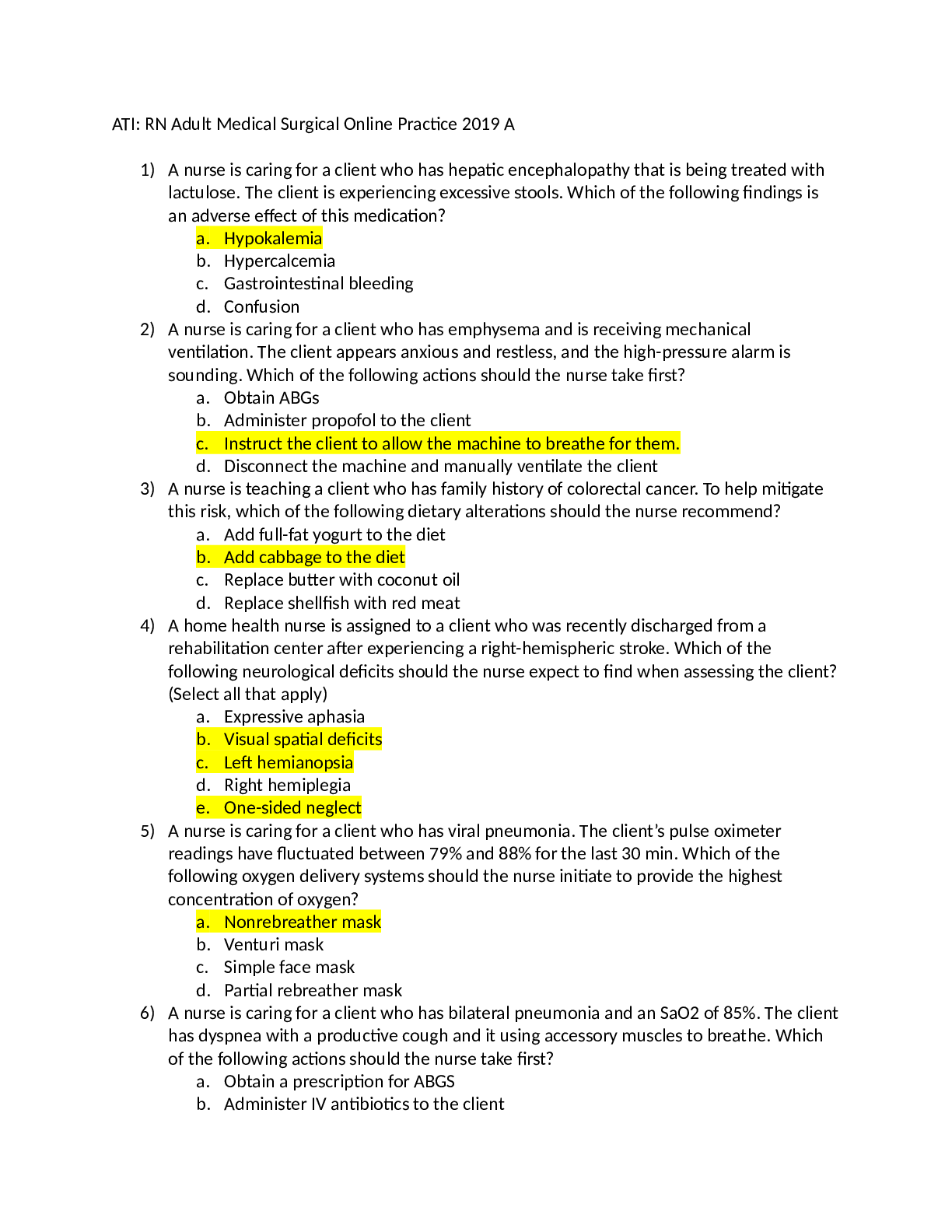
Reviews( 0 )
Document information
Connected school, study & course
About the document
Uploaded On
Jun 25, 2021
Number of pages
16
Written in
Additional information
This document has been written for:
Uploaded
Jun 25, 2021
Downloads
0
Views
60


.png)
